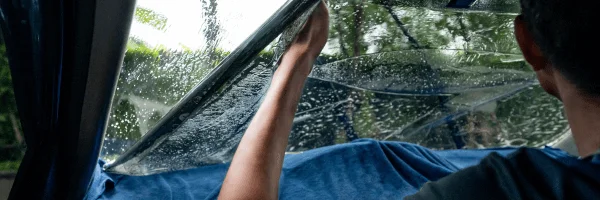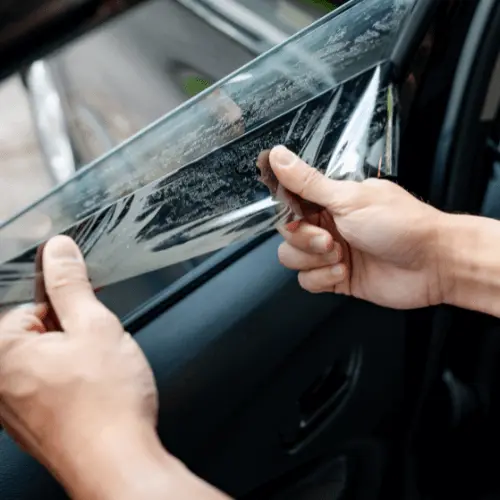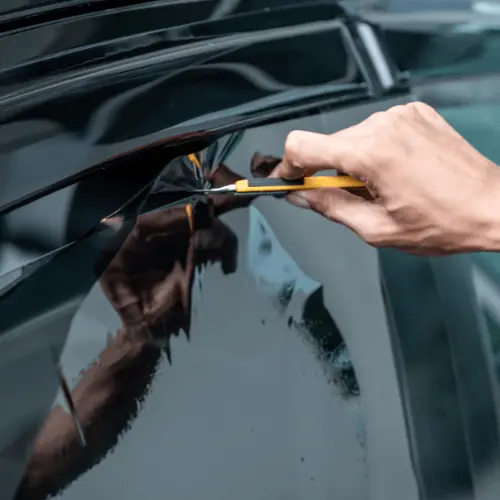Washing Tinted Windows: Best Practices and Maintenance Tips 2025
You must maintain clean tinted windows to protect their appearance and functional lifetime. The improper washing of tint film produces damaging effects that result in delamination of the material, bubble formation, and colour changes. This guide will demonstrate effective methods for washing tinted car windows that will protect their durability.
Why Proper Cleaning Matters
Special care needs attention when cleaning tinted windows car because it helps stop scratches from appearing, minimizing streaks, and delaying film deterioration. The incorrect mix of cleaning materials together with improper cleaning procedures will erode the tint adhesive and reduce the lifespan of the transparent film. Proper technique enables you to achieve impressive cleaning results with no tint film deterioration.

Materials and Their Uses
|
Material |
Purpose |
|
Tint-safe window cleaner |
Cleans without damaging the tint |
|
Mild dish soap & water |
Gentle alternative for removing dirt |
|
Microfiber cloths |
Prevents scratches and streaks |
|
Soft sponge |
Gently lifts dirt without harming the film |
|
Spray bottle |
Evenly distributes cleaning solution |
|
Squeegee (optional) |
Helps remove excess water for a streak-free finish |
Best Cleaning Practices for Tinted Windows
1. Use the Right Cleaning Solution
- The application of ammonia-based cleaners should be avoided because these products break down the tint film over time.
- You should use a tint-safe commercial cleaner and a solution of water mixed with mild soap.
2. Choose Soft Cleaning Materials
- A microfiber cloth together with a soft sponge will protect the windows from scratches.
- The use of paper towels along with abrasive scrubbers should be avoided because they can cause damage to the tint.
3. Follow Proper Cleaning Techniques
- To minimize damage to the tint film apply cleaning solution on a cloth than directly applying it to the window.
- Move the cleaning cloth gently in circular patterns or straight paths in order to prevent streaks.
4. Dry Thoroughly
- An excess of moisture can be easily removed from the surface using a dry microfiber cloth.
- Excessive rubbing caused by cleaning motions will damage the adhesive process of window tinting due to its long-term effects.
Step-by-Step Guide to Washing Tinted Windows
1. Prepare the Cleaning Solution:
- Mix a few drops of mild dish soap with warm water in a spray bottle.
2. Spray and Wipe:
- Lightly spray the cleaning solution onto the microfiber cloth.
- Gently wipe the tinted surface, starting from the top and working your way down.
3. Dry the Surface
- Use a clean microfiber cloth to dry the window completely.
- If streaks appear, repeat the process with a fresh cloth.
4. Inspect and Finish
- Check for remaining spots or streaks and clean them accordingly.
The Best Way to Wash Tinted Windows
The Problem
Many car owners struggle with keeping their tinted windows clean without causing damage. Common concerns include:
- Scratches & Peeling – Improper cleaning methods can scratch or peel the tint film.
- Streaks & Residue – Some cleaners leave behind streaks, making visibility worse.
- Chemical Damage – Harsh chemicals can weaken or discolor the tint over time.
- Longevity – Frequent washing with the wrong products reduces the lifespan of tinted windows.
We needed to find the best cleaning method that ensures clarity, preserves the tint, and avoids damage.
The Solution
To determine the most effective cleaning method, we tested two common approaches:
- Traditional Cleaning – Using ammonia-based glass cleaners and paper towels.
- Tint-Safe Cleaning – Using ammonia-free cleaners and microfiber cloths.
Each method was tested on identical cars with professionally installed tint and exposed to the same environmental conditions.
The Results
After four weeks of testing, here’s what we observed:
|
Category |
Traditional Cleaning |
Tint-Safe Cleaning |
|
Clarity |
Left streaks and hazy spots |
Provided crystal-clear visibility |
|
Damage Risk |
Tint edges started peeling |
No visible damage |
|
Durability |
Slight discoloration over time |
Tint remained unchanged |
|
Ease of Use |
Required extra wiping |
Quick and efficient cleaning |
|
Cost-Effectiveness |
Frequent reapplications needed |
Longer-lasting results |
The Outcome
- Clearer Windows: The tint-safe method left no streaks, ensuring better visibility.
- No Damage: Ammonia-free cleaners preserved the tint film without peeling or fading.
- Extended Lifespan: Using the right cleaning method helped maintain the tint’s durability.
- Efficient Cleaning: Microfiber cloths required less effort for a spotless finish.
- Long-Term Savings: Preventing damage reduces the need for costly tint replacements.
Key Takeaway
For maintaining optimal condition of tinted windows the use of traditional ammonia-based cleaners should be avoided. A mixture of tint-safe cleaner and microfiber cloth will produce a stained-free surface that protects your window tint. You can achieve both extended life and appealing visual quality of tinted windows through this method for multiple years.
Common Mistakes to Avoid
- Using Ammonia-Based Cleaners: The application of ammonia-based cleaners will ultimately lead to discoloration of the tint film followed by gradual peeling occurrences.
- Scrubbing Too Hard: Too vigorous cleaning will result in visible scratches and damage to the adhesive bonds.
- Ignoring the Edges: A bubble and peel effect will develop whenever water stays trapped beneath the edges of the tinted surface.
- Cleaning Too Soon After Installation: Caring for tinted windows during the first week after installation requires your patience because you should delay cleaning the windows.
Final Thoughts
It is important to maintain tinted windows through proper care because this practice guarantees their clarity and extends their lifespan. Proper cleaning methods along with non-harmful solutions will allow your colored windows to remain damage-free and fresh for multiple years.






